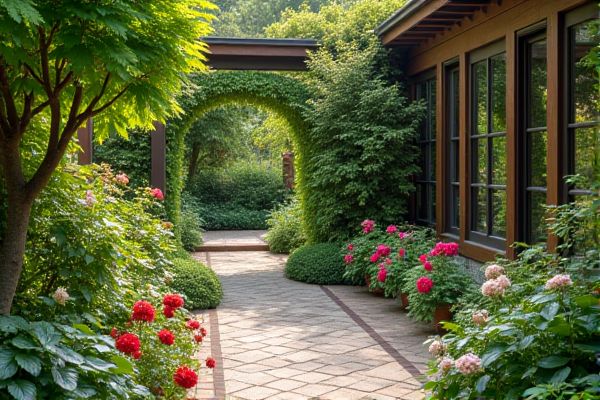
Herb gardens on terraces offer fresh, aromatic ingredients for your kitchen, enhancing both flavor and convenience, while flower gardens provide vibrant colors and fragrances that create a relaxing outdoor ambiance. Discover which option best suits your space and lifestyle by reading the rest of the article.
Table of Comparison
| Aspect | Herb Garden (Terrace) | Flower Garden (Terrace) |
|---|---|---|
| Primary Purpose | Growing culinary, medicinal, and aromatic herbs | Growing ornamental flowers for aesthetics and fragrance |
| Plant Types | Basil, mint, rosemary, thyme, parsley | Roses, marigolds, petunias, geraniums, tulips |
| Maintenance | Moderate; requires regular watering and pruning | Moderate to high; needs watering, deadheading, and pest control |
| Space Requirement | Compact, suitable for small terrace spaces | Varies; may require more space for diverse flowers |
| Sunlight | Full sun to partial shade (4-6 hours/day) | Full sun to partial shade (6-8 hours/day), depending on species |
| Benefits | Fresh herbs for cooking, natural remedies, pest repellent | Visual appeal, attracts pollinators, improves mood |
| Growth Cycle | Perennial and annual herbs, quick growth | Annuals and perennials, seasonal blooms |
| Water Needs | Moderate; avoid waterlogging | Varies; some flowers need frequent watering |
Introduction: Herb Garden vs Flower Garden on a Terrace
Herb gardens on terraces offer practical benefits like fresh culinary ingredients and natural remedies, while flower gardens enhance aesthetic appeal and attract pollinators such as bees and butterflies. Your choice depends on whether you prioritize edible plants with functional uses or vibrant blooms that elevate the terrace ambiance. Both garden types can thrive in compact spaces with proper soil, sunlight, and regular maintenance.
Space Utilization: Maximizing Terrace Potential
Herb gardens on terraces maximize space utilization by allowing vertical planting and compact arrangements, making them ideal for small areas. Flower gardens often require more spreading space for aesthetic appeal, limiting terrace capacity. Efficient herb garden designs enhance terrace potential by combining functionality with greenery.
Aesthetic Appeal: Greenery vs Blossoms
Herb gardens on terraces offer a vibrant palette of lush green foliage that creates a calming, fresh atmosphere ideal for relaxation and culinary use. Flower gardens, by contrast, provide bursts of colorful blossoms that enhance the visual appeal with dynamic hues and seasonal changes, attracting pollinators like bees and butterflies. The choice between greenery and blossoms depends on whether the primary goal is functional foliage or decorative vibrancy.
Maintenance Requirements and Ease
Herb gardens on terraces demand lower maintenance, requiring minimal watering and occasional pruning, making them ideal for busy gardeners. Flower gardens typically need more frequent watering, deadheading, and pest control to maintain vibrant blooms. Choosing herbs reduces upkeep time while still providing fresh, usable plants in a compact space.
Functional Benefits: Culinary vs Decorative Use
Herb gardens on terraces provide fresh, aromatic ingredients that enhance culinary dishes with natural flavors and nutritional benefits, making them particularly valuable for home cooks and health enthusiasts. Flower gardens primarily serve decorative purposes, enriching terraces with vibrant colors and pleasant aromas that create a visually appealing and relaxing environment. While herbs contribute directly to food preparation, flower gardens emphasize aesthetic beauty and emotional well-being through sensory appeal.
Environmental Impact and Pollinator Support
Herb gardens on terraces contribute significantly to environmental sustainability by requiring less water and fewer chemical inputs compared to flower gardens, reducing your ecological footprint. They support pollinators such as bees and butterflies by offering diverse nectar sources throughout the growing season, enhancing urban biodiversity. Flower gardens also attract pollinators with vibrant blooms but often demand more intensive maintenance and water usage, making herb gardens a more eco-friendly choice for terrace cultivation.
Cost of Setup and Ongoing Expenses
Setting up a herb garden on your terrace generally requires lower initial investment compared to a flower garden, as herbs often need simpler soil, pots, and minimal fertilizers. Ongoing expenses for an herb garden remain economical since herbs can self-seed and require less frequent replacement or specialized care. In contrast, a flower garden demands higher maintenance costs due to periodic purchase of seasonal flowers, fertilizers, pest control, and potential replanting efforts.
Sensory Experience: Fragrance, Color, Texture
Herb gardens offer a rich sensory experience with vibrant green leaves, aromatic scents like basil and rosemary, and varied textures from soft mint to rough sage, enhancing your terrace with natural fragrance and tactile diversity. Flower gardens bring bursts of color from blossoms such as roses and marigolds, paired with sweet or subtle scents that attract pollinators, creating a visually stunning and fragrant outdoor space. Choosing between them depends on whether you prioritize aromatic herbs for culinary use or colorful petals for decorative appeal on your terrace.
Seasonal Variation and Year-Round Interest
Herb gardens on terraces offer year-round interest due to many perennial and evergreen species like rosemary, thyme, and chives that thrive in varied seasons, providing fresh culinary ingredients and aromatic foliage. Flower gardens, while visually vibrant with seasonal blooms like tulips in spring and chrysanthemums in fall, often require replanting or rotation to maintain color and appeal throughout the year. Selecting a mix of hardy herbs and seasonal flowers can enhance terrace garden diversity, balancing continuous greenery with bursts of colorful floral displays.
Best Plants for Terrace Herb and Flower Gardens
Terrace herb gardens thrive with Mediterranean herbs like basil, rosemary, thyme, and oregano, which require well-drained soil and full sun exposure, making them ideal for compact spaces with ample sunlight. Flower gardens on terraces benefit from sun-loving blooms such as geraniums, petunias, marigolds, and lavender, which attract pollinators and add vibrant color while tolerating container growth. Your choice depends on maintenance preference and desired function, with herbs offering culinary benefits and flowers providing aesthetic appeal and biodiversity.
 homyna.com
homyna.com